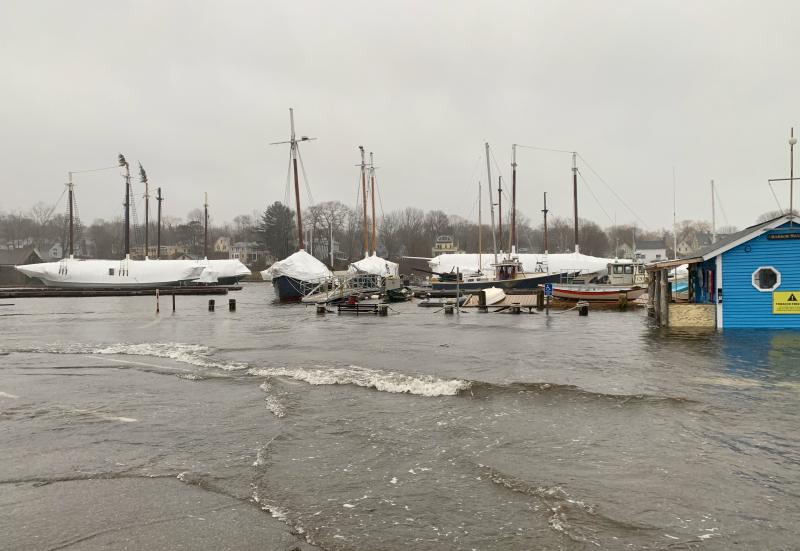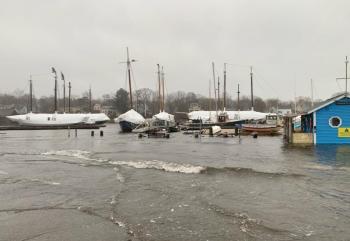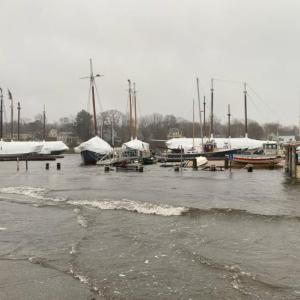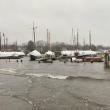Camden must pursue meaningful harbor resiliency plans
The storms of January 10-11 and January 13 of this year, as well as the storm of December 23, 2022, have certainly brought home the cold hard facts of climate change as it relates to Camden Harbor and the grave environmental and economic impact that will result if we fail to find ways to mitigate these changes.
A short walk around the harbor shows the extreme damage to business, residential, and town-owned properties. Virtually every property from our cherished Laite Beach Park to the Camden Public Landing sustained significant damage. Many properties along the north shore of the outer harbor including the heavily used Steamboat Landing were also severely damaged.
The majority of damage in the harbor was caused by wind-driven waves and storm surge. The strength and size of wind-driven waves are determined by something called “fetch”. Fetch is the distance over the water that the wind blows. The longer the fetch, the higher and stronger the waves are.
There are several significant issues here that impact everyone who lives or works in Camden. This is not just a harbor problem. This is an everyone problem.
The impacts include the environment of the harbor, the economic impact of lost wages for those who work in affected businesses, and the loss of revenue to the local businesses those workers patronize.
In the future, there will also be a long-term loss of tax revenue if these damaged properties cannot be repaired and lose value as a result. The damage by future storms is bound to be worse. This lost tax revenue will inevitably be spread to the entire tax base of Camden, affecting all properties, even ones far from the harbor.
The potential environmental damage from erosion or breaches of seawalls is staggering. In the current regulatory environment, there are significant limitations on what can be done to strengthen these structures, regardless of how effective the measures would be. But if there is not going to be a coordinated effort by Camden to pursue meaningful resiliency plans, individual property owners will need to do their own much less effective measures within the framework of local ordinances, and state and federal regulations.
Much of what we consider to be Camden Harbor is a result of fill being placed behind seawalls and dredging performed in the 19th Century to suit the industrial needs of the town at that time. We may not like it, but the fact remains that we have no idea what hazards are in that fill behind those seawalls. Because of this, it is safe to say that the fill is best left covered and protected instead of large amounts of it ending up in the harbor.
We also must be honest that a big part of what brings visitors to Camden and what made many current residents who are not from Camden want to move here is the current configuration of the harbor, with an inner harbor deep enough for the windjammer fleet, commercial fishing boats, and recreational boats. These boat owners and visitors use the services of businesses such as Lyman Morse, P. G. Willey, the restaurants, and the other downtown businesses. The ripple effect economically goes in both directions. What is bad for these businesses is bad for all of us.
It is easy to see what we have now when we look at the harbor. It is difficult to really imagine what the harbor will look like if we fail to protect it, and seawalls begin to breach.
How many of these storms will we need to absorb before we act? If we fail to act, how far are we prepared to allow the erosion to go? To the base of Bay View Street? Or Chestnut Street? Or Route 1?
Once the fill starts to spill into the harbor, will we try to actively remove it? Who will pay for that? How much will it cost? Where will we put it? This would be a very slow motion environmental and economic disaster for those who live and work here, and those who love to visit.
I was born in Camden and have been boating in and around this area since I was nine. I can testify that the impact of climate change is real. Since the mid 1940s, there has been talk of protecting Camden Harbor via a breakwater as Rockland Harbor has been protected since 1899.
I was 12 when I first heard about the idea of a breakwater for Camden. The reasoning was always that it would make the harbor a safer and more desirable anchorage for commercial and recreational boats, and that would bring more business to the town. It would also save the town and businesses money by negating the need to remove floats during severe storms.
While all of this is true, it had always been deemed too expensive to justify the cost. But the main reason seems quite different now. Not that the economic arguments of the past are not reasonable. They are. But now it is existential for the harbor and even for Camden.
The Holly Bean Shipyard (the property immediately to the Sherman’s Cove side of Steamboat Landing), the Camden Marine Railway Company (the site of the three Harbor House condominium buildings), and steamships that used Steamboat Landing were businesses that operated in the last half of the 19th and early 20th centuries. They did not need a breakwater for their work. The severity and frequency of storms were likely different then. But this is now, and the facts on the ground have changed.
In 2007, the Town of Camden petitioned the Army Corps of Engineers to do a Federal Interest Determination Study regarding the feasibility of protecting Camden Harbor with breakwaters.
In 2016, the Corps determined, in a 73-page report, that breakwaters were a reasonable option to protect the harbor, but further study was needed to finalize environmental impacts, design and cost estimates.
The $500,000 cost of this study would have been equally split between the Corps and Camden. Camden ultimately decided to forgo this joint study due to cost. This decision by Camden may have been the right one then, but things have changed. Unfortunately, because this offer from the Army Corps has expired, a request to the Corps to consider this again would need to be resubmitted by the town. Camden should resubmit this request to keep all viable options for climate change resiliency on the table.
On January 12, the day after the most severe storm, I was in Rockland on business. I had some extra time, so I walked from one end of Rockland Harbor to the other. During that walk, it was obvious that a natural experiment had taken place for all to see.
The portion of Rockland Harbor covered by the breakwater had no wind-driven wave damage. The portion not covered by the breakwater, starting at the Landings Marina was a disaster, with upended piers and buildings. One could draw a straight line from the end of the breakwater to the beginning of the damage.
I would invite everyone who lives, works, or loves Camden to do the following thought experiment: You, alone, are tasked with keeping strong coastal storms and the inevitable hurricanes that will come as the Gulf of Maine warms from causing severe environmental and economic damage to Camden. Your family’s physical lives and economic security hang in the balance based on your success or failure. Your name will also be enshrined on a monument to you on the Village Green letting future generations know of your thought process and decisions. What are the top five actionable interventions that you would investigate? What would be your top option if you could only enact one?
These are the difficult decisions we all need to confront. We need our town officials to be on the record with their harbor resiliency plans and the reasoning for their positions. Past decisions are just that. Past decisions based on past circumstances. There should be no room for blame or shame if different decisions are made now in light of our current circumstances.
If a careful review of data from experts indicates that breakwaters will help us, we should reconsider them. If the data shows that they will not, we should set the idea aside. Shame and blame should be reserved for anyone not willing to be convinced by data, regardless where the data leads us.
Breakwaters are incredibly expensive to build and maintain. But the cost of inaction is high as well, and possibly much higher than building breakwaters. No solution will be without economic and environmental impact. We need to choose the best of the imperfect solutions available to us, and not let solid solutions be the enemy of perfect but imaginary ones.
An often-overlooked benefit of breakwaters is that they would allow the shorelines protected by them to require less armoring. This would allow more of the harbor’s shoreline to be protected by vegetation and the environmental benefits that it brings.
I am 61. I have been lucky enough to boat in this area for 52 years, and to live on the harbor for the last seven years. When I was a kid, I made money working in many capacities in and around the harbor. I mowed most of the lawns in the neighborhood in which I now live. In the mid 1980s, I watched the building that I call home being built while I was teaching children and adults to sail.
My home sits high enough above the harbor that I likely do not have enough time left to be personally impacted by the worst of what is to come. But that doesn’t mean that I do not have an obligation to keep the harbor and the town that has done so much for my family and me the best that it can be for as long as possible. We all do.
Jeffrey Jordan lives in Camden





























